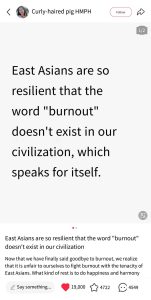In Australia’s multicultural workplace environment, “mental health” and “burnout” have gradually become the center of discussion in the wake of the epidemic. The story of Bethany, an Australian woman who quit her executive position due to work-related stress, once again reveals a disturbing reality: the modern workplace is often an “invisible enabler” of mental health problems.
However, as the third largest immigrant group in Australia, the Chinese community often disappears from such discussions. What is even more shocking is that there is no word in Chinese that exactly corresponds to the word “burnout”. And in fact, the problem is real among Chinese immigrants to Australia, but language and cultural “silencing mechanisms” make it difficult for Chinese people to speak up.
As suggested in Feature Writing, feature is the social storytelling that goes ‘beneath the surface’ by recording individual feelings — Through individual stories, it reflects the different workplace systems formed in different cultures and creates effective social discussions (Stephen, et al.,9, 2017).
I will use the genre of feature to explore the topic of mental health in the Australian workplace, trying to find out whether Chinese people in the Australian workplace are silently burning out, whether they are caught in the gap between Chinese and Western cultures — On the one hand, there is the traditional East Asian concept of “being tough and not showing vulnerability”, and on the other hand, there is the Australian workplace culture that requires boundaries to be set and emotions to be expressed in a timely manner. Through interviewing several Chinese practitioners in Sydney, I will explore whether Chinese people in the Australian workplace are also generous and open in saying burnout.
The article is planned to be published on Ins as well as the Chinese platform Xiaohongshu, targeting young working adults, mental health practitioners and the Australian Chinese community. This article explores “whether burnout in different cultural contexts can be timely and accurately expressed”, which is a cross-cultural + workplace + psychological complex issues. Ins, Xiaohongshu, as a popular online discussion platform in China and Australia, is very suitable for publication, in order to fine-tune the publicity of the article, aiming to the young population of two languages and two types of cultural identity.

Source:Rednote
Through interviews with Chinese workers and reviewing the Australian Bureau of Statistics’ mental health report on migrants, the article will include data on Chinese workplace stress, provide pages on multilingual mental health services in Australia, and more. This strategy references the role of “data journalism” in news dissemination to enhance readability and communication (Paul, 255, 2024).
This is not an article about individual vulnerability, but rather a social and public health issue: burnout is not just about physical exhaustion, but also about the linguistic and cultural powerlessness of not being able to speak. To build a truly diverse and inclusive workplace, Australia cannot afford to ignore these silent voices.
Words:490
References
Paul, B. (2024). Data journalism. In The online journalism handbook : skills to survive and thrive in the digital age. Routledge.
Stephen, T., Nick, R., & Molly, K. (2017). The Digital Feature. In Feature writing : telling the story. Tanner, Stephen.


Be the first to comment